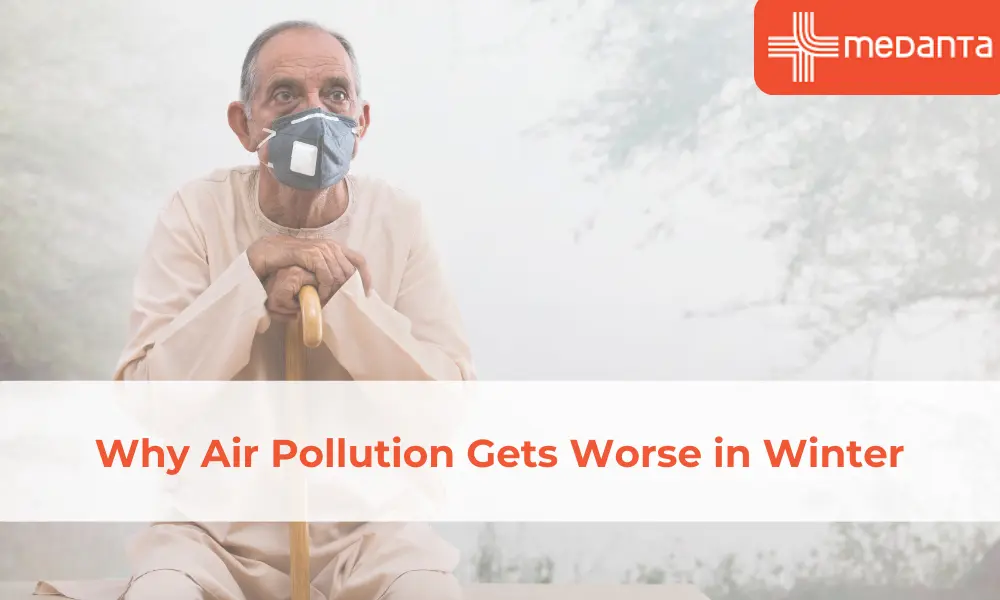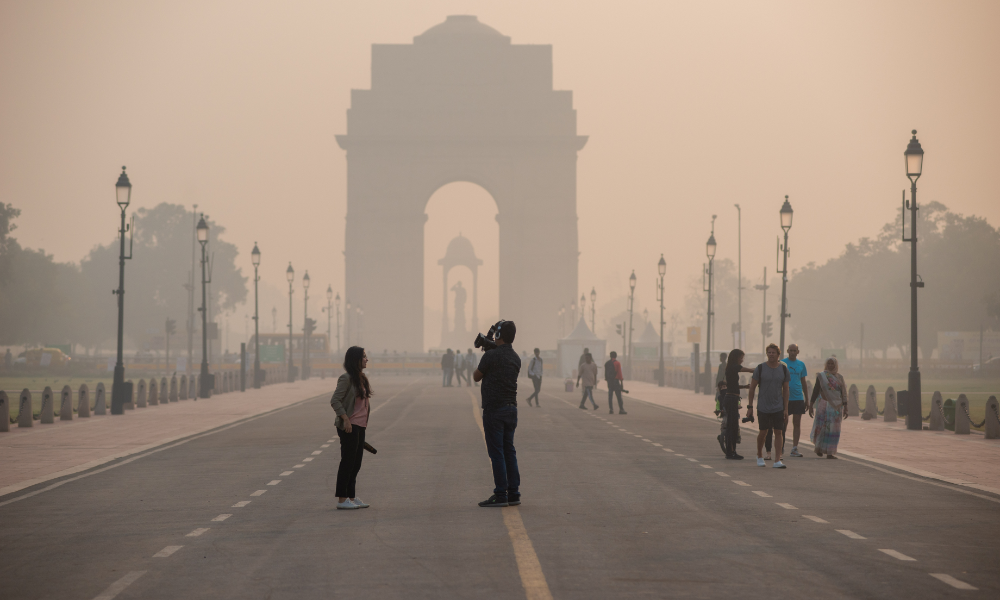Why Air Pollution Gets Worse in Winter

TABLE OF CONTENTS
Air pollution becomes more dangerous as temperatures start falling. At the time winter sets in, pollution levels climb to alarming heights. Breathing becomes harder in winter and with good reason too. Multiple factors work together to create this seasonal hazard. You must be surprised to know that PM2.5 levels reach exceptionally high during winters. This poses serious health risks.
Winter weather patterns make things worse. Cities located in valleys or basins face a unique challenge. Cold air gets trapped near the ground levels (because of thermal inversions). This creates a natural barrier that stops pollutants from dispersing. Dust plays a major role too.
This article looks at the science behind winter's pollution surge. It explains how temperature inversions trap harmful particles and shows how human activities make the problem worse during cold months.
Why does Winter Trigger More Pollution?
Winter's arrival after autumn creates perfect conditions for poor air quality. Weather patterns work together to make pollution worse and harder to clear during cold months.
Change in wind direction after monsoon
Monsoon season's end brings dramatic changes in wind patterns. Recent studies show that unusual delays in monsoon withdrawal have led to toxic PM2.5 levels. Anti-cyclonic circulation takes over after monsoons and traps pollutants in colder conditions. Wind direction changes affect both air quality and impact zones. Smoke aerosols can then travel far from their source and form elevated layers.
Lower temperatures and stagnant air
Winter brings cold, dense air that acts like a blanket trapping pollutants near the ground. This happens because:
Cold air's density leaves less space between gas molecules
Dense air moves slower and keeps pollution trapped
Warm air passes over the cold layer instead of rising to carry pollutants away
Dense winter air creates a "lid" that stops pollutants from spreading. This explains why the Air Quality Index (AQI) follows a clear pattern - better in summer but much worse from autumn through winter.
Reduced rainfall and dust accumulation
Winter sees much less rain, which means fewer natural cleanings of the air. Less precipitation reduces atmospheric mixing & lets particles build up.
People seal their homes tightly to keep heat inside. Indoor dust that contains dirt particles, dead skin, fibres and microscopic materials stays on surfaces because there is less ventilation.
Urban areas face special challenges with their many pollution sources. Heat islands make it harder for pollutants to disperse, and no rain means pollution stays longer. Dry winter conditions let dust build up everywhere, which makes breathing problems worse for many people.
The Science Behind Winter Air Stagnation
The winter sky might look peaceful, but a scientific phenomenon lurks beneath that makes air pollution worse.
What is temperature inversion?

Temperature inversion happens when the normal atmospheric pattern flips (warm air rests above cooler air near the ground). This pattern differs from nature's typical gradient where temperature decreases with height. The atmosphere becomes stable and vertical mixing stops.
Four main types of inversions affect air quality:
Ground inversions form on clear nights when surface air cools faster
Turbulence inversions develop when calm air overlies turbulent air
Subsidence inversions occur when large air masses sink and warm
Frontal inversions happen when cold air undercuts warm air
Some regions experience these inversions throughout the year, and they can occur up to 330 days annually.
How inversion traps pollutants near the ground
Picture an inversion as a city's lid. Scientists explain that winter's extended high-pressure systems cause the ground to heat up during the day but cool off at night. The layer of warm air above then acts like a lid keeping pollutants close to the ground.
Pollution builds up in the mixing layer below the inversion level because natural ventilation stops working. The pollution's severity depends on the inversion's strength, duration, and height. The more severe the inversion, the more pollutants become trapped and build up.
Role of low wind speed in pollution build-up
Air stagnation occurs when atmospheric movement drops below critical levels.
Pollutants need wind speeds above 15 km/h to disperse effectively. However, low speeds let contaminants accumulate. Cities that experience air stagnation events show PM2.5 concentrations higher than during non-stagnant periods.
Winter pollution crises emerge from this dangerous combination of temperature inversions and low wind speeds.
Human Activities that Worsen Winter Air
Natural factors combine with human activities to push winter pollution to dangerous levels. Our daily actions & seasonal agricultural practices make poor air quality substantially worse.
1. Stubble burning and its seasonal timing
Farmers clear their fields by burning crop residue every October and November, which releases massive pollution plumes. This practice happens at the worst possible time (right when winter weather conditions become unfavourable).
Cities near these burning sites experience a dramatic rise in pollution levels. Research shows this practice leads to a rise in PM2.5 and an increase in PM10 concentrations between October and November. Court judgments have opposed this practice, yet economic pressures and limited alternatives keep farmers burning stubble.
2. Increased vehicle emissions in cold weather
Cold weather turns vehicles into pollution machines. Cars idle longer and produce high cold-start emissions in freezing temperatures. The numbers tell a stark story—particulate matter emissions multiply and nitrogen oxides increase in cold conditions.
Vehicle emission control systems need warmth to work. These systems require higher temperatures to work. Raw pollutants escape freely on cold winter mornings until your vehicle systems become warm.
3. Construction and road dust in dry months
Dry winter months turn construction sites into pollution hotspots. Dust from cement mixing, template cutting, and rock drilling stays suspended in stagnant winter air.
Silica particles in construction dust harm workers and nearby residents. This pollution spreads without rain to settle it down. City authorities often fail to control construction site pollution which adds substantially to winter air problems.
4. Use of biomass and wood for heating
People often turn to wood for warmth as temperatures drop, which makes air quality worse. Wood burning releases substantial pollution (despite its "renewable" label).
Biomass burning releases particulate matter, nitrogen oxides, carbon monoxide, sulphur dioxide, lead, mercury, and other hazardous air pollutants. Harmful pollutants from wood smoke such as carbon monoxide and particulate matter stay trapped in winter's stagnant air. This heating method could cause more harm than the fossil fuels it tries to replace.
Conclusion
Winter changes our air into a dangerous cocktail of pollutants that damage our health. The atmosphere develops an invisible barrier over cities at the time temperature inversions occur. Stagnant air stops the natural cleaning process, which traps harmful particles near ground level where we breathe instead of letting them rise.
Human activities make this natural problem worse. Farmers burn stubble, cars put out more pollution when it's cold, dust comes up from dry areas, and fires from wood add harmful stuff to the air. These pollution episodes create serious health risks as they persist through winter. People's health conditions worsen, especially when you have older adults or those with breathing issues. Each year brings predictable increases in hospital visits while vulnerable groups struggle with worsening symptoms.
Science explains why winter creates such poor air quality. Weather patterns may be beyond our control, but we can change how our activities affect the situation. The community's understanding of these seasonal risks is the foundation of protecting public health in cold weather.
FAQs
Why does air pollution worsen during the winter months?
Air pollution intensifies in winter due to temperature inversions, where warm air traps cooler air near the ground, creating a 'lid' that prevents pollutants from dispersing. This, combined with low wind speeds and reduced rainfall, leads to the accumulation of harmful particles in the air we breathe.
How does cold weather affect air quality?
As we have now learnt that cold air is dense and moves more slowly. It allows pollutants to become concentrated near the ground. There is a lack of atmospheric mixing in cold conditions. Thus, contaminants remain trapped in the lower layers of air leading to poor air quality.
What human activities contribute to increased winter pollution?
Several human activities exacerbate winter pollution, including:
Stubble burning by farmers
Increased vehicle emissions due to cold starts
Construction dust in dry conditions
Use of biomass and wood for heating
Are there health risks associated with winter air pollution?
Yes winter air pollution puts you at a risk of more medical conditions. The higher concentration of particulate matter (PM2.5 & PM10) can lead to increased respiratory & cardiovascular issues. Cold polluted air can cause airway inflammation & prolonged exposure during winter pollution. Thesde episodes can be dangerous for vulnerable groups.
How does winter air pollution in cities compare to other seasons?
Winter air pollution in cities is often more severe than in other seasons. PM10 levels can reach higher in winter, far exceeding WHO safety limits. Cities may experience around 10 days of severe or worse air quality, with pollution episodes lasting up to four consecutive days due to unfavourable weather conditions.






